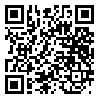BibTeX | RIS | EndNote | Medlars | ProCite | Reference Manager | RefWorks
Send citation to:
URL: http://tbj.ssu.ac.ir/article-1-1906-en.html
Abstract
Introduction: Antimony trioxide (Sb2O3) has been utilized as a catalyst in polyethylene terephtalate (PET) production, and the studies conducted on the bottled water has demonstrated that antimony can be leached from PET bottles into drinking water.
Methods: In this study, a simple method was applied in order to determine the trace amount of antimony in bottled drinking water based on preconcentration /solid phase extraction. The nano alumina modified with Schiff base ligand was used in regard with Sb preconcentration. The experiments were performed in a continuous system and HCI was used as eluent of Sb ion. Several chemical and flow variables were optimized for a quantitative preconcentration and determination of Sb ion. The atomic absorption spectroscopy was used to determine Sb ion concentration. In order to study the keeping conditions on the leaching of Sb ion from PET plastic, drinking water bottles were kept in different conditions(room temperature, sunny light and -18˚C).
Results: The calibration graph was linear in the range of 0.5 to 15.0 ppm Sb with detection limit of 0.055 ppm. The flow rate of sample was optimized in range of 1.0-9.0 mLmin-1 and Sb ion can be quantitatively eluted at 90 Vsample: Veluent retio.
Conclusion: The study results revealed that the modified nano alumina is an effective sorbent in regard with absorbing Sb ion from water and HCI 1M can be used as an appropriate eluent. Maximum leaching of Sb ion is observed when the bottled drinking water was exposed to the sun light.
Keywords: Antimony; Bottled drinking water; Modified alumina; Preconcentration
Received: 2016/01/19 | Accepted: 2016/01/19 | Published: 2016/01/19
| Rights and permissions | |
 |
This work is licensed under a Creative Commons Attribution-NonCommercial 4.0 International License. |





